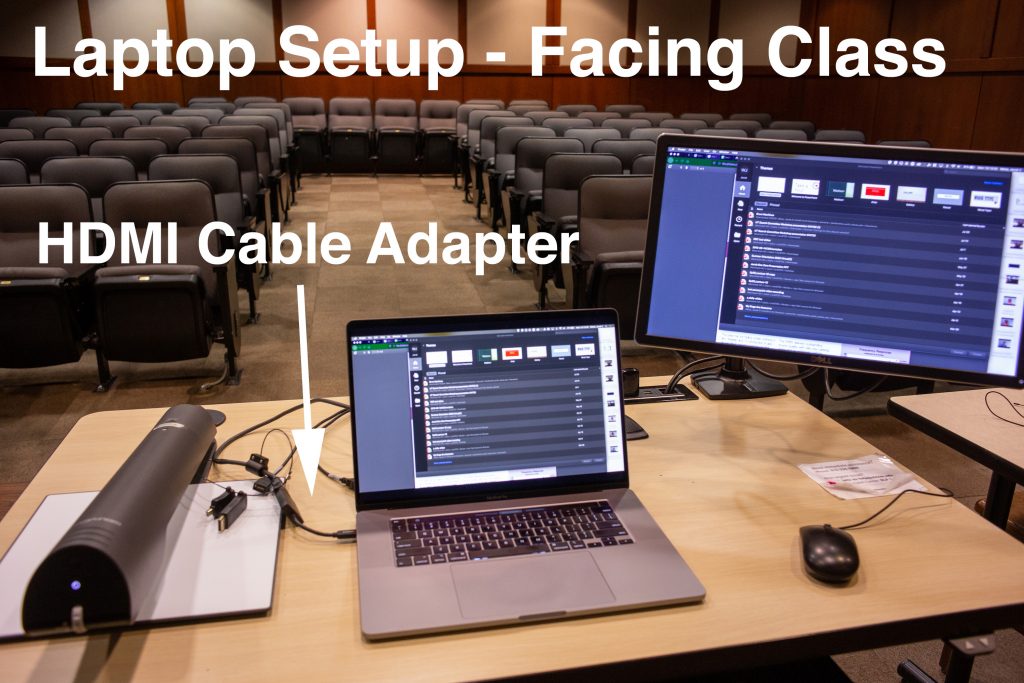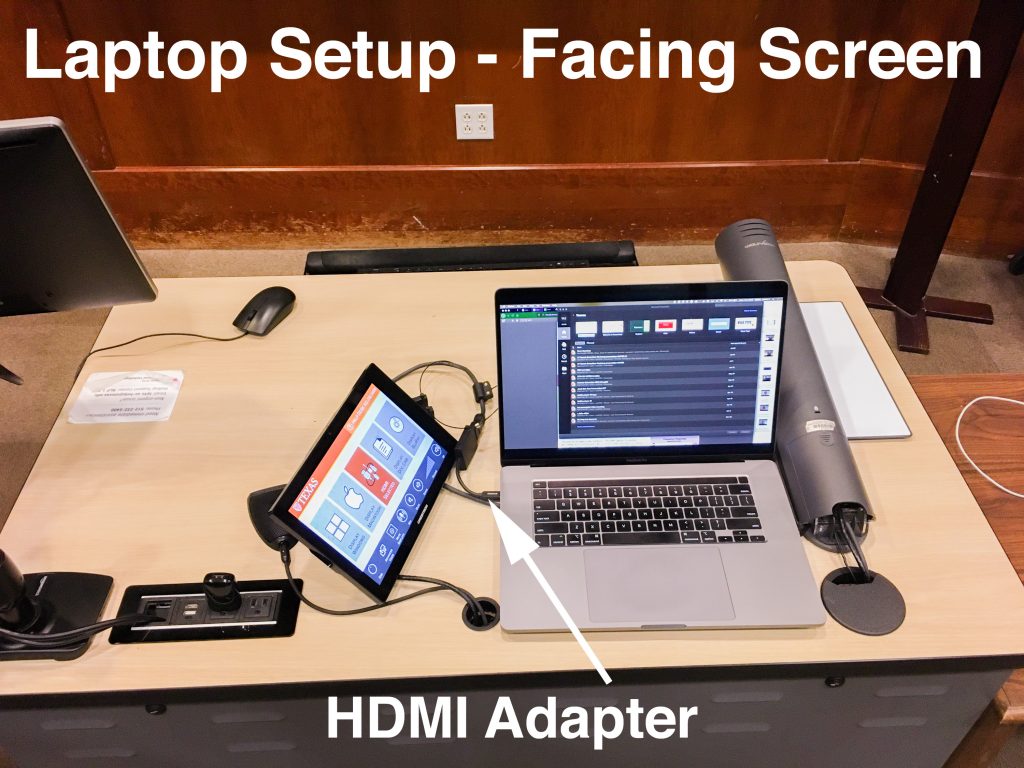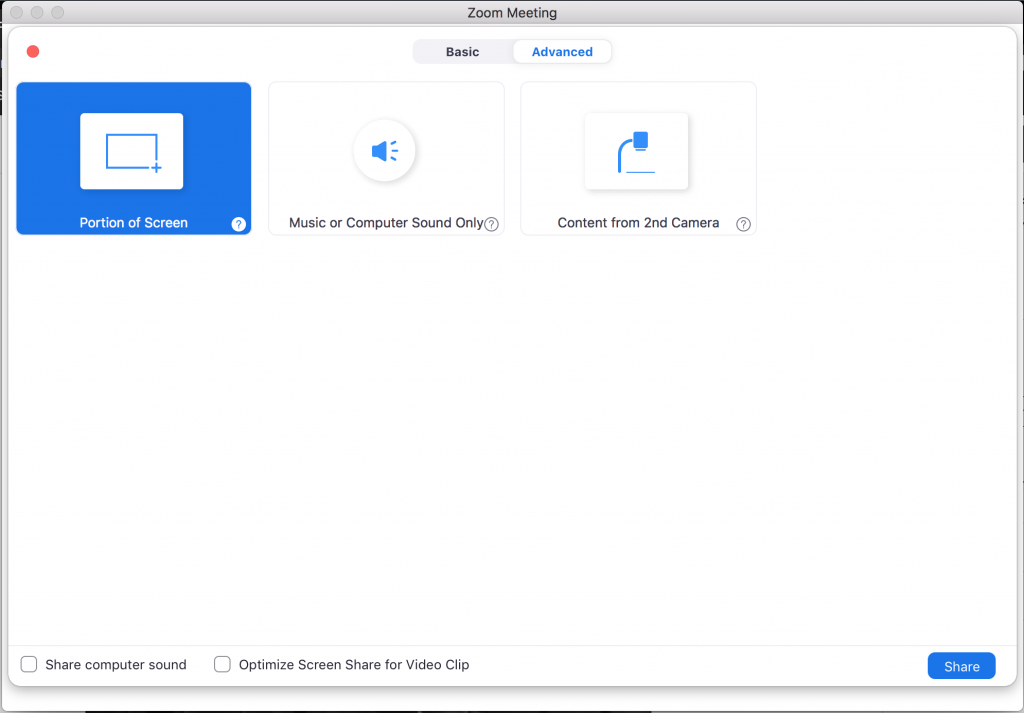Use this guide if the room normally seats 100 or more students.
Capturing a large classroom for the audience at home will require more investment if you are including classroom discussion. While it may seem difficult to bridge the gap between in-class and at-home students, figuring out which of these three setups is best suited for your teaching style can help you to do so.
Press the right-facing arrow next to each setup to view it below:
Setups
Standing Up Front, Built-in Webcam or External Webcam Facing Lecturer
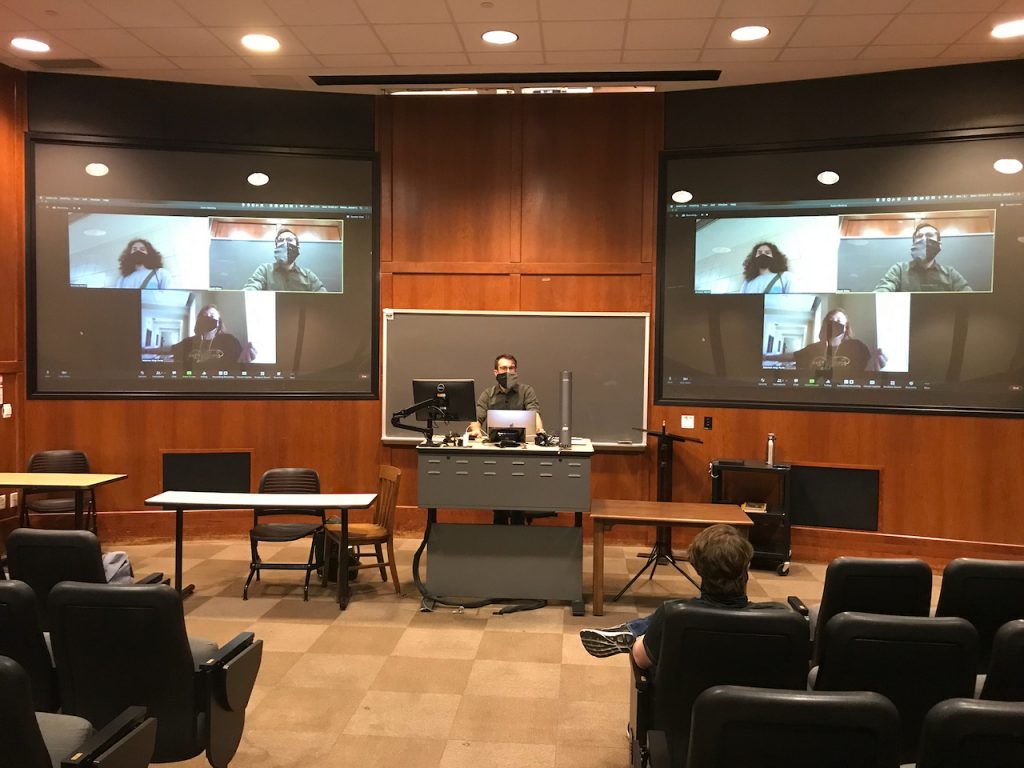
This is a standard setup that you may be used to.
At-home students are able to get a good view and sound from you, but they’re unable to see the students in the classroom. Discussion between at-home students and in-person students will be difficult with a built-in laptop camera. An external webcam will help much more with picking up students in the classroom.
This is an ideal setup if discussion is not as necessary to your class.
Here is a short example of how at-home students will experience this setup:
If this is the setup you want to use, here is what your cabling will look like:
Laptop Setup (if you plan on running applications off your laptop)
The image on the left uses an external webcam. If you’ve decided to use an external webcam, your cable connections will look similar to those in the image. You’ll need to connect your laptop to the console via HDMI. You’ll also need to connect your webcam to your laptop via USB. Depending on your laptop, you may need to use the HDMI and USB cable adapter.
The image on the right uses the laptop’s built-in webcam. If you’ve decided to use your own laptop’s built-in webcam, you’ll only need to connect your laptop to the classroom console with the HDMI cable. Depending on your laptop, you may need to use the HDMI cable adapter.
Computer Console Setup (if you plan on running applications off the classroom’s console)
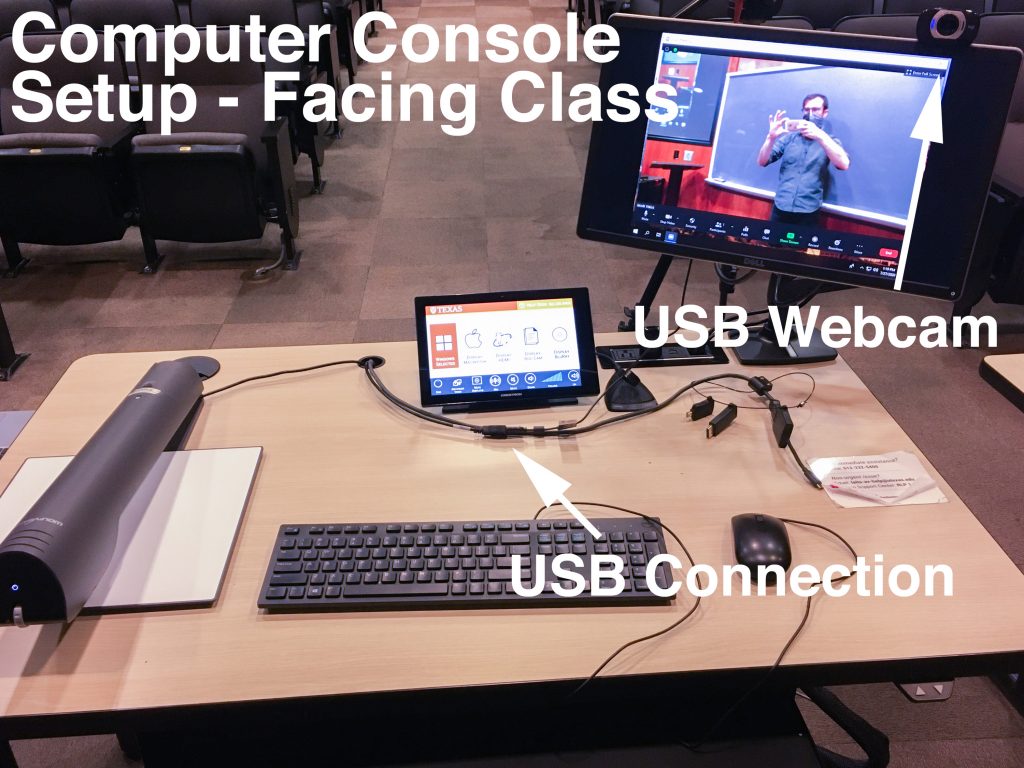
You will need an external webcam if you plan on running this setup off the classroom’s computer console. In fact, it’s all you’ll need.
Lecturer and Class, External Webcam, Side-Angle
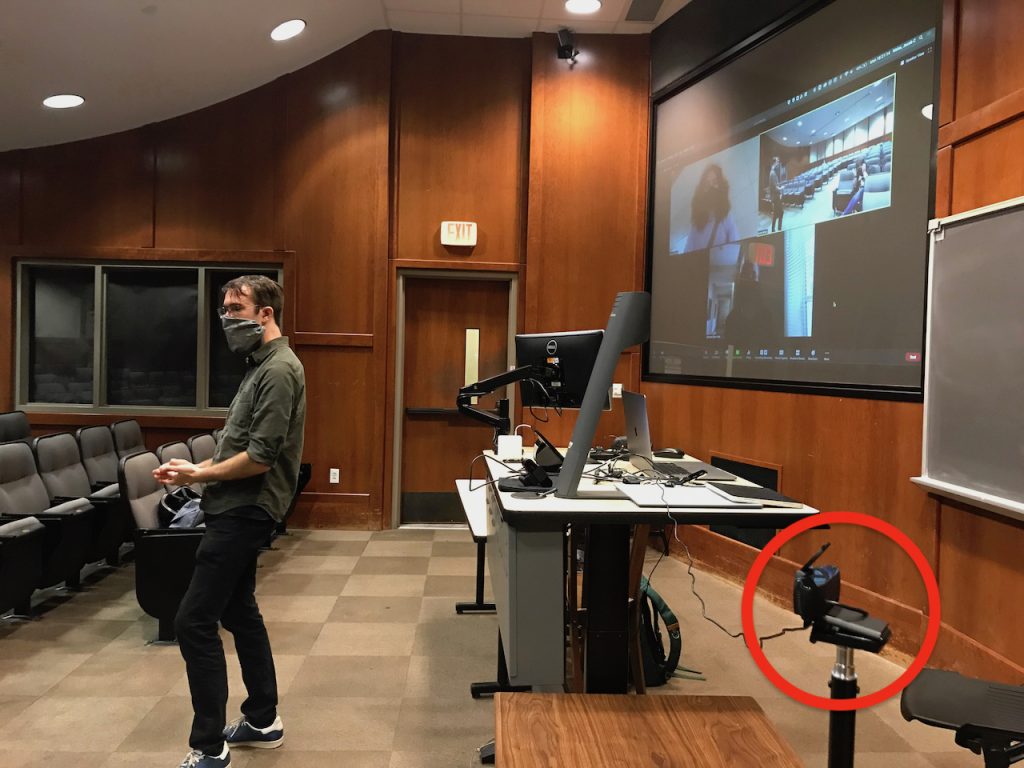
This setup can help facilitate discussion between in-class and at-home students.
The camera, located at the bottom right of the photo, offers a wider view of the classroom. At-home students are able to see the classroom discussion, as well as the professor. You will need to make sure to stand close to the camera so your audio is picked up well.
Here is a short example of how students will experience this setup:
Students at home can feel like they’re part of the discussion. The lecturer and in-classroom students can be heard a bit more clearly, and at-home students get a good view of what’s going on in the classroom.
This setup will only work with an external webcam.
If this is the setup you want to use, here is what your cabling will look like:
Depending on whether or not you plan on using your personal laptop, the setup will be different. Rather than attaching your external webcam to the monitor you’re using, you’ll need to find a spot to the right or left of your desk to place your webcam and stand.
We recommend purchasing a stand that will rise up from the floor, since it is more easily moved and has more options for angles:
- AmazonBasics Lightweight Camera Mount Tripod
- Selfie Stick Tripod – Currently unavailable on Amazon
Lecturer and Class Facing Computer

The laptop is placed on the desk and faces the classroom, and you’ll face the laptop to lecture. For discussion, you’ll have to move to face either in-class or at-home students.
The downside to this setup is that there will always be a group of students facing your back. You’ll also have to move out of the way for discussion and turn towards the computer to sound clear. However, the microphone can pick up the audience better since it is facing them.
Here is a short example of how students will experience this setup:
We recommend using the Logitech Brio webcam for this setup because the microphone on the camera will best pick up discussion from the back of the room. Using a built-in laptop microphone will not be as effective.
If this is the setup you want to use, here is what your cabling will look like:
Laptop Setup (if you plan on running applications off your laptop)
The image on the left uses an external webcam. If you’ve decided to use an external webcam, your cable connections will look similar to those in the image. You’ll need to connect your laptop to the console via HDMI. You’ll also need to connect your webcam to your laptop via USB. Depending on your laptop, you may need to use the HDMI and USB cable adapter.
The image on the right uses the laptop’s built-in webcam. If you’ve decided to use your own laptop’s built-in webcam, you’ll only need to connect your laptop to the classroom console with the HDMI cable. Depending on your laptop, you may need to use the HDMI cable adapter.
Computer Console Setup (if you plan on running applications off the classroom’s console)
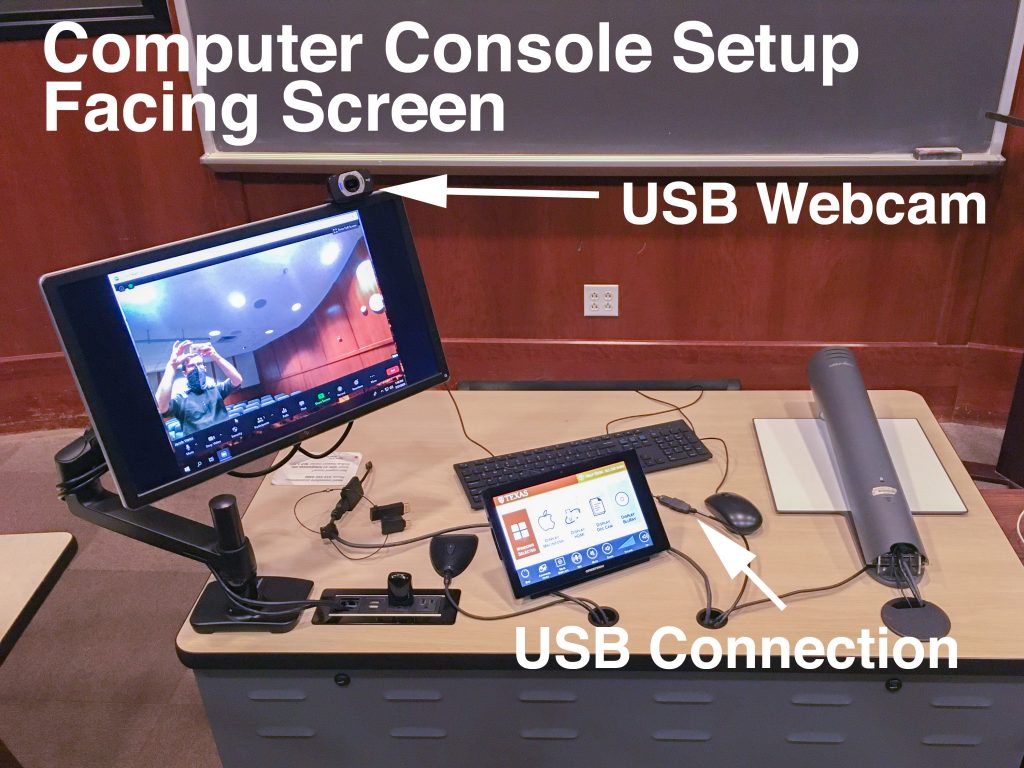
You will need an external webcam if you plan on running this setup off the classroom’s computer console. In fact, it’s all you’ll need.
Sharing Content via Screen-Share
Steps to Set Up Screen-Share
Regardless of the setup you use, you can always count on sharing content via screen-share using these easy steps:
- Pull up the Zoom window
- In the toolbar along the bottom, find and click the button that says “Share Screen” in green
- A new window will appear asking what you would like to share, allowing you to choose from individual applications or desktops
- Click whichever you’d like to share, and it will be made visible to the class!
When you are done sharing your screen, simply navigate to the top center of the window and click “Stop Share.”
Here is a short example of how this feature works:
Content You Can Share
As you can see, there are many different ways in which you can share content with screen-share.
For example, if you want to share computer audio only, navigate over to the Advanced Screen-Share options by clicking “Advanced” at the top center of the screen, and then click “Music or Computer Sound Only.”
Recommended Equipment
Webcam Options
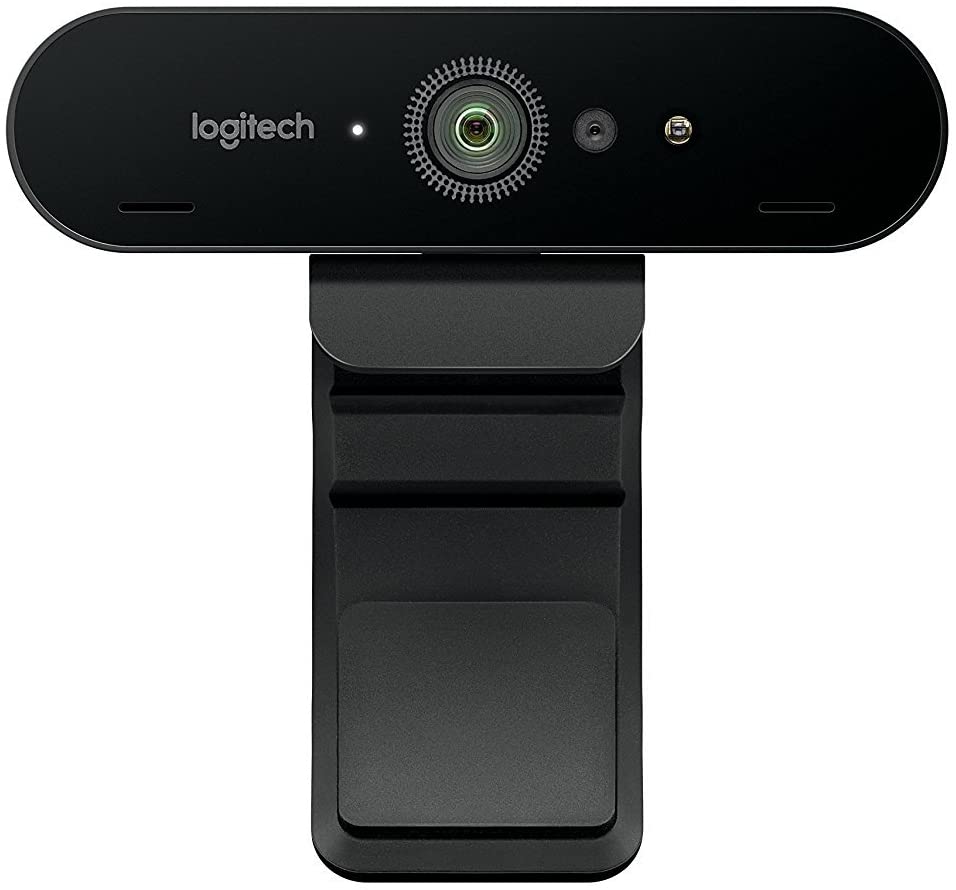
Logitech BRIO Ultra HD 
Logitech C930e 
Logitech C615
*NOTE – Depending on how the USB adapters are set up in the computer consoles in certain classrooms, there may not be enough USB bus power to properly power a webcam. If possible, we encourage you to test out your webcam in the classroom ahead of your first class if you are going to use this method.
When lecturing in a large classroom, you want to make sure at-home students can hear you and the in-person students at the back of the room.
Logitech BRIO Ultra HD
Of the setups we tested, the Logitech BRIO Ultra HD webcam’s built-in microphone was the only one that could reach the back of the classroom. Additionally, the webcam’s microphone was able to pick up the lecturer even when they had their back facing the webcam. For a large classroom such as this one, this is the webcam we recommend.
Here are links to where you can buy this webcam:
Logitech C615
Similar to the Logitech C930e, this webcam works well, but its microphone doesn’t pick up students seated far from the webcam or the lecturer when their back is turned.
Here are links to where you can buy this webcam:
- Logitech – Currently out of stock
- Walmart
- Amazon
- Grooves Inc – Ships from Germany, takes 1-2 weeks
Webcam Stands
If you decide to use the Side-Angle setup, you’ll need a webcam stand.
Here are a few options:
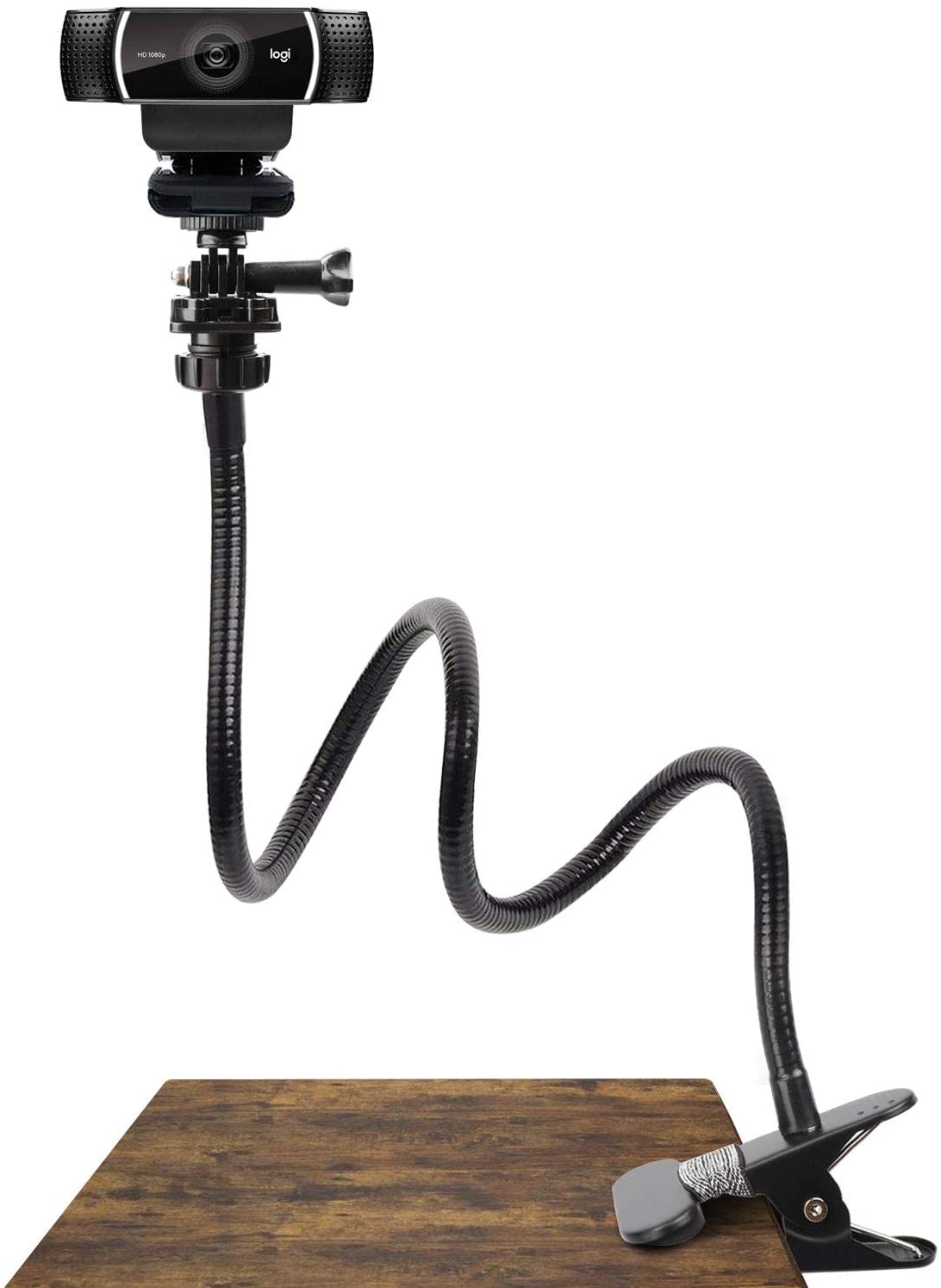
25 Inch Webcam Stand 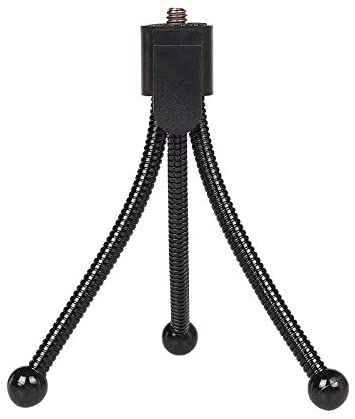
LarmTek Webcam Stand 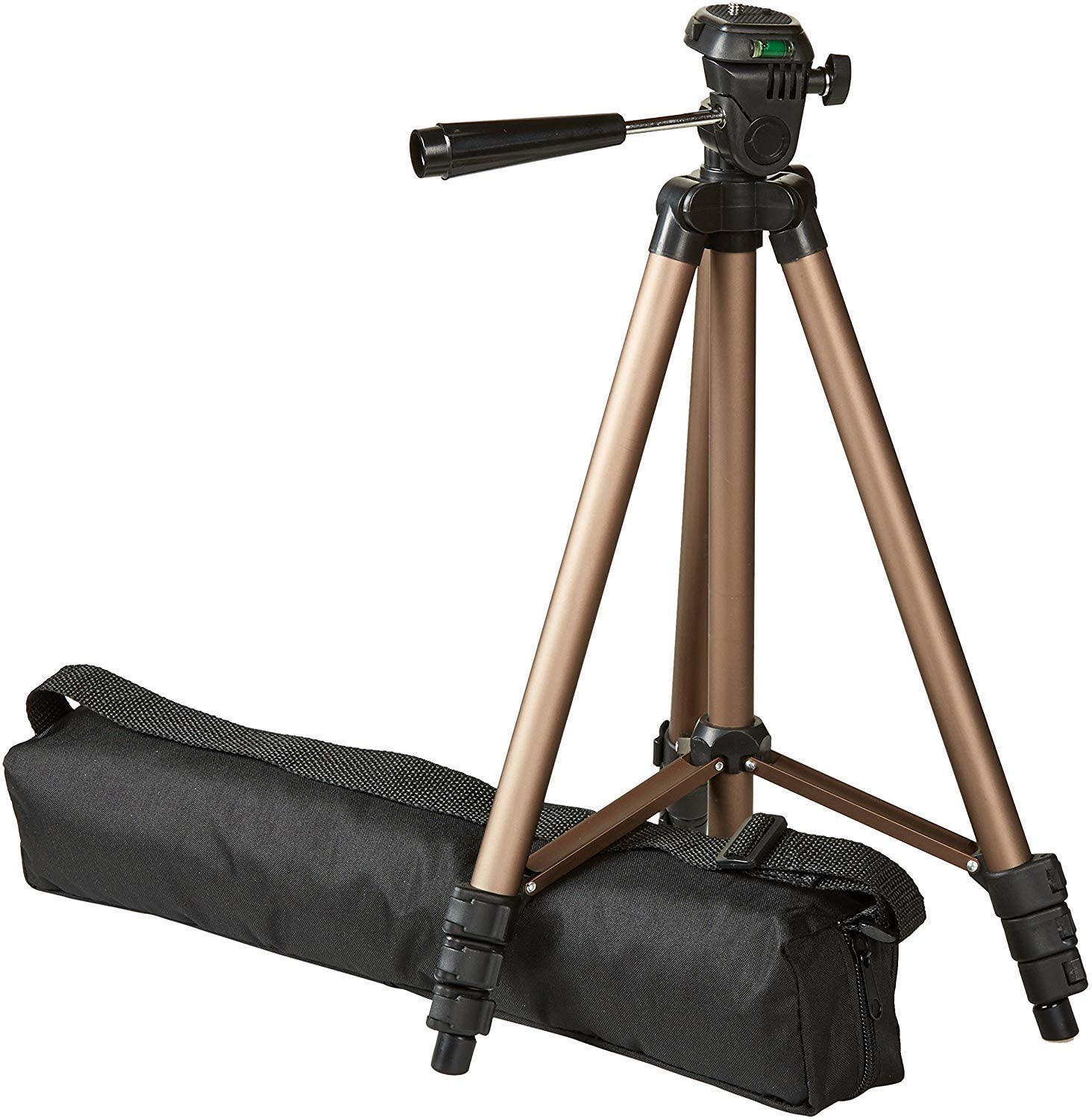
AmazonBasics Lightweight Camera Mount Tripod 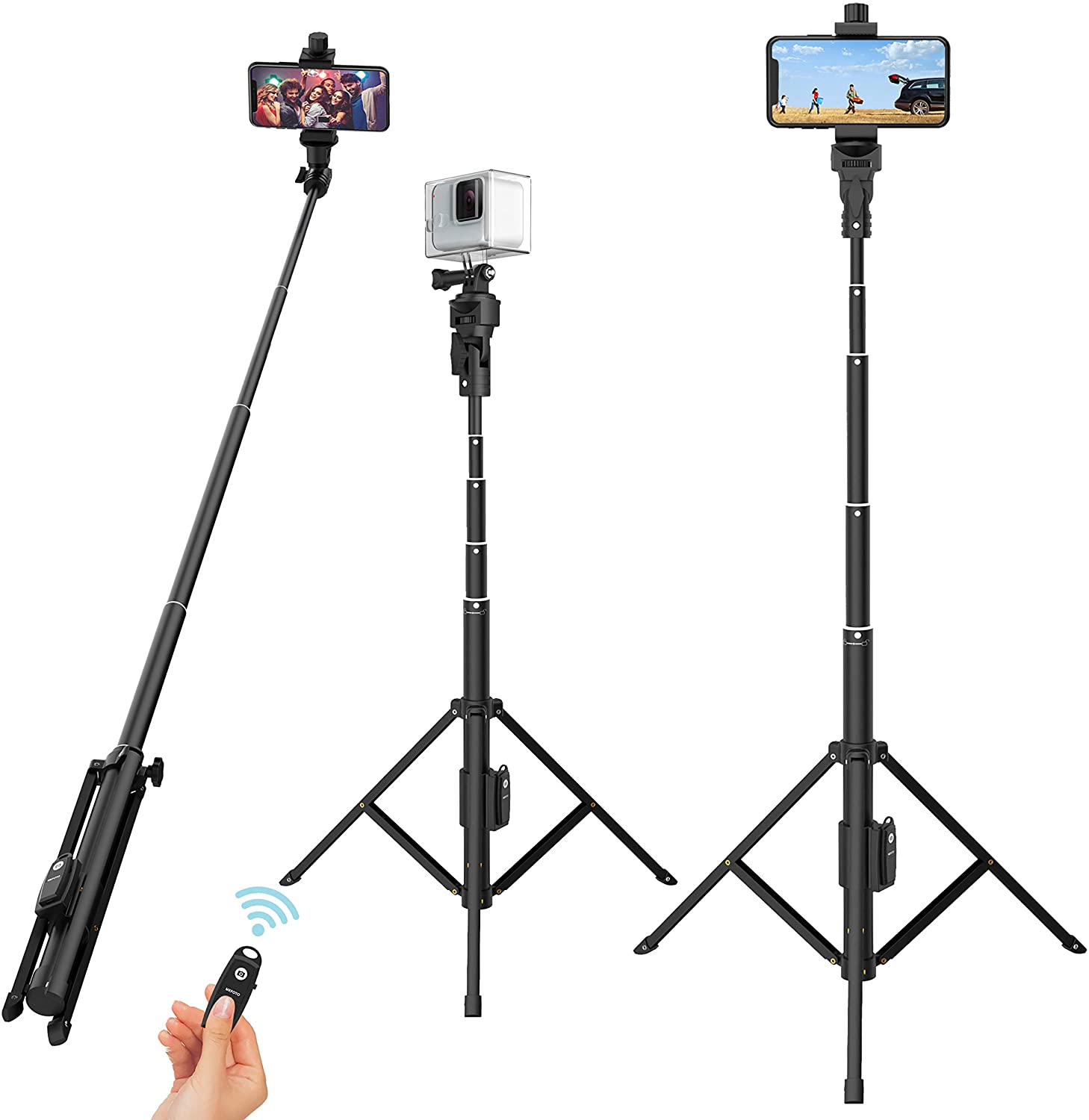
Selfie Stick Tripod
Here are the links to purchase these stands:
- 25 Inch Webcam Stand
- LarmTek Webcam Stand
- AmazonBasics Lightweight Camera Mount Tripod
- Selfie Stick Tripod – Currently unavailable on Amazon
In addition, you may need an extension cable depending on where you place your webcam. You can find a USB extension cable here.
Setting Up Your Webcam
External Webcam
Laptop Setup (if you plan on running applications off your laptop)
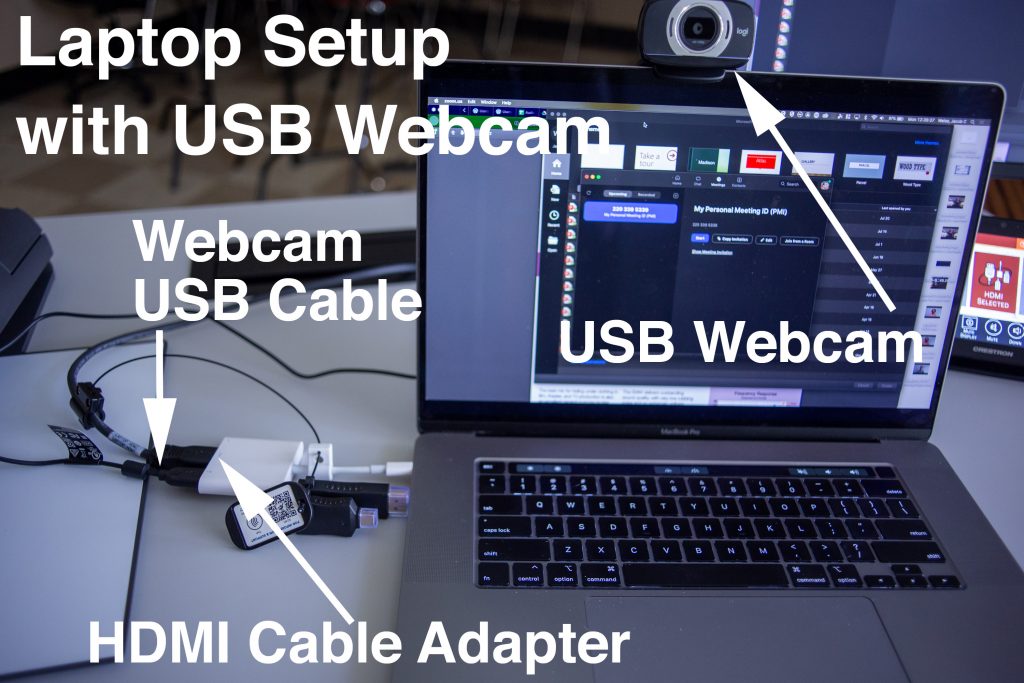
If you’ve decided to use an external webcam, your cable connections will look similar to those in the image. You’ll need to connect your laptop to the console via HDMI. You’ll also need to connect your webcam to your laptop via USB. Depending on your laptop, you may need to use the HDMI and USB cable adapter.
If you want to use the side-angle classroom setup, your cable connections will still look like those in the image, but instead of placing the webcam on your laptop, you’ll find a spot in the room to place it on your stand. Make sure to purchase a USB extension cable if your webcam’s cable doesn’t reach the console’s cable, or if you don’t have enough slack. Having a little extra cable can help you avoid accidents such as tripping over the cable or toppling the webcam. The USB extension cable link can found at the bottom of Webcam Stands under Recommended Equipment.
Computer Console Setup (if you plan on running applications off the classroom’s console)
If you decide to run off the classroom’s console, then you only need to plug your webcam in via USB.
If you want to use the side-angle classroom setup, your cable connections will still look like those in the image, but instead of placing the webcam on the console’s screen, you’ll find a spot in the room to place it on your stand. Make sure to purchase a USB extension cable if your webcam’s cable doesn’t reach the console’s cable, or if you don’t have enough slack. Having a little extra cable can help you avoid accidents such as tripping over the cable or toppling the webcam. The USB extension cable link can found at the bottom of Webcam Stands under Recommended Equipment.
Personal Laptop’s Built-In Webcam
If you’ve decided to use your own laptop’s built-in webcam, you’ll only need to connect your laptop to the classroom console with the HDMI cable. Depending on your laptop, you may need to use the HDMI cable adapter.
Recommendations for Hybrid Classroom Teaching
Recommendations for Lecturing
Most modern microphones sound good if used properly.
Whether you use a smartphone, laptop, headphones, or a professional microphone, microphones largely depend on two factors to sound good:
- The closer you are to a microphone (within reason), the better you will sound. This is why you hold a phone up to the side of your mouth when you talk or hold a microphone up to your mouth when you are speaking at a conference or singing karaoke.
- The quieter your environment and the room you are in, the better your audio will sound. If students are talking and the classroom is noisy, it may be difficult for Zoom participants to hear properly. Loud ambient noises like AC or fans may also cause a problem. Although it is often difficult to control in a classroom, minimizing these kinds of noises when possible is recommended.
Regardless of your setup, it would be beneficial for the lecturer to repeat any questions or discussion points brought up by in-class students to the at-home students. Doing so helps them stay connected to what is happening in the classroom.
Recommendations for At-Home Students
In order to listen to Zoom participants, you’ll need to connect your computer to the classroom console. Once you do so, your computer’s audio will output to the classroom sound system, and both you and your students will be able to hear when Zoom participants ask questions.
Students on Zoom will need to be given the ability to mute and unmute themselves, but they should all remain on mute until they are called on or have a question. Using the built-in speakers on your computer as an alternative is not recommended as this could lead to feedback (and will also make it harder to hear students on Zoom).
However, some classes may not be equipped to output your computer’s audio. In this case, built-in speakers might be the best option.
Computer Settings
Computer Settings to Check Before a Recording or Broadcast
- Always remember to plug your computer into a charger if you are using a laptop. Not only will you ensure your computer battery does not die during your class, but most laptops operate faster and with more power if they are connected to external power sources.
- Close out of all applications that you do not need for your video session. The fewer programs that you have open, the more processing power and RAM your computer will have access to.
- Turn off computer notifications. Notifications can be distracting when you are trying to lecture, and they can get in the way of your computer screen if you are sharing materials. You can find instructions on turning them off here:
- If possible, the day before a broadcast or recording, we recommend you check to make sure all of your software is up to date. This could include Zoom, PowerPoint, your Operating System, and any additional software you are using.
